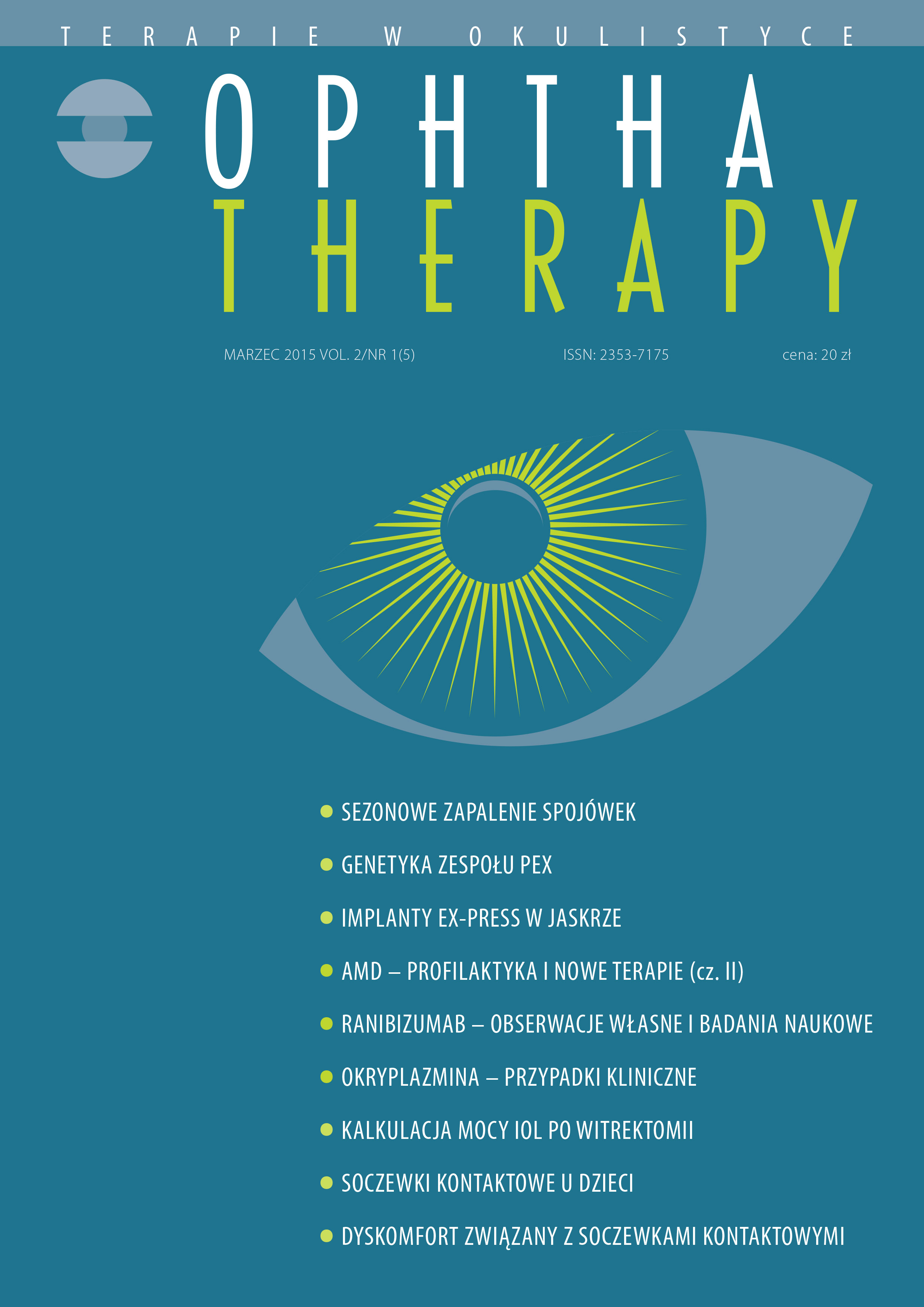Ocriplasmin in vitreomacular traction syndrome – own experience
Main Article Content
Abstract
Ocriplasmin influence on posterior vitreous detachment (PVD) and vitreomacular traction (VMT) at patients treated in Ophthalmology and Ocular Oncology Clinic of University Hospital was evaluated. The paper presents results of the best corrected visual acuity (BCVA), images of swept source optic coherence tomography (OCT) and our experiences related with employment ocriplasmin at 4 patients. Patients were evaluated according to new classification of Vitreomacular Interface (VMI).
Material and methods: Four patients (4 eyes with vitreomacular traction) were treated with 0,125 mg ocriplasmin (jetrea 0,5 mg/0,2 ml) intravitreal iniection. Duration of clinical signs of symptoms, the degree of disease severity (according to International Traction Study, IVTS, Group), presence of posterior vitreous detachment and resolution of vitreomacular traction and best corrected visual acuity (BCVA) improvement were evaluated. BCVA, ophthalmoscopy using Volk lens and swept source optical coherent tomography (OCT) were performed in all patients.
Results: In 2 eyes (50%) total posterior vitreous detachment and vitreomacular traction was achieved. The BCVA improvement, withdrawn of symptoms, central scotomas and metamorphopsies were observed in patients. It has undergone decrease of vitreomacular traction after treatment at one patient 25%, central scotomas and metamorphopsies. We observe no changes at one patient after employed treatment (25%). The vitreous body detachment events (lasting 1 day vitreous floaters, photopsia, floaters) appeared in all treated patients. Subretinal fluid absorption and BCVA improvement were observed in effective treated patients during follow-up. No one patient had present treatment related complications.
Conclusions: Enzymatic vitreolysis with ocriplasmin for vitreomacular traction is effective and safe treatment, which can be alternative management for both strategies: “watch and wait” or vitrectomy.
Downloads
Article Details

This work is licensed under a Creative Commons Attribution-NonCommercial-NoDerivatives 4.0 International License.
Copyright: © Medical Education sp. z o.o. License allowing third parties to copy and redistribute the material in any medium or format and to remix, transform, and build upon the material, provided the original work is properly cited and states its license.
Address reprint requests to: Medical Education, Marcin Kuźma (marcin.kuzma@mededu.pl)
References
2. Jackson TL, Nicod E, Simpson A et al. Symptomatic vitreomacular adhesion. Retina. 2013; 33: 1503-11.
3. Duker J, Kaiser PK, Binder S et al. The International Vitreomacular Traction Study Group classification of vitreomacular adhesion, traction, and macular hole. Ophthalmology. 2013; 120(12): 2611-9.
4. JETREA® Summary of Product Characteristics ThromboGenics NV. Belgium; January 2013.
5. Sebag J. Molecular biology of pharmacologic vitreolysis. Trans Am Ophthalmol Soc. 2005; 103: 473-94.
6. Matsumoto B, Blanks JC, Ryan SJ. Topographic variations in the rabbit and primate internal limiting membrane. Invest Ophthalmol Vis Sci. 1984; 25: 71-82.
7. Stefanini FR, Maia M, Falabella P et al. Profile of ocriplasmin and its potential in the treatment of vitreomacular adhesion. Clinical Ophthalmology. 2014; 8: 847-56.
8. Kim BT, Schwartz SG, Smiddy WE et al. Initial outcomes following intravitreal ocriplasmin for treatment of symptomatic vitreomacular adhesion. Ophthalmic Surg Lasers Imaging Retina. 2013; 44: 334-43.
9. Singh RP, Li A, Bedi R et al. Anatomical and visual outcomes following ocriplasmin treatment for symptomatic vitreomacular traction syndrome. Br J Ophthalmol. 2014; 98: 356-60.
10. Warrow DJ, Lai MM, Patel A et al. Treatment outcomes and spectral-domain Optical Coherence Tomography findings of eyes with symptomatic vitreomacular adhesion treated with intravitreal ocriplasmin. Am J Ophthalmol. 2014 [article in press].
11. Hiscott PS, Grierson I, McLeod D. Natural history of fibrocellular epiretinal membranes: a quantitive, autoradiographic and immunohistochemical study. Br J Ophthalmol. 1985; 69: 810-23.

